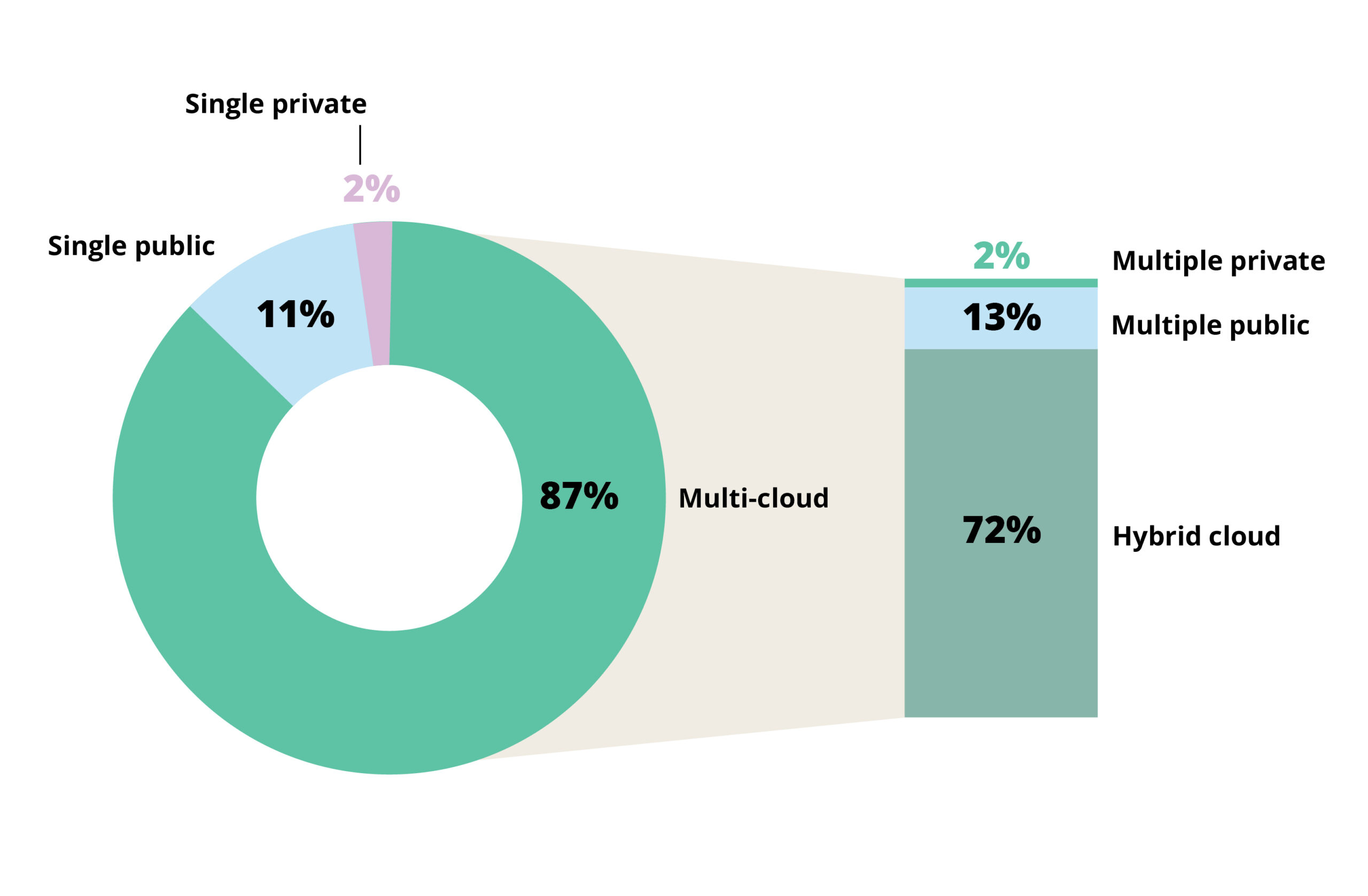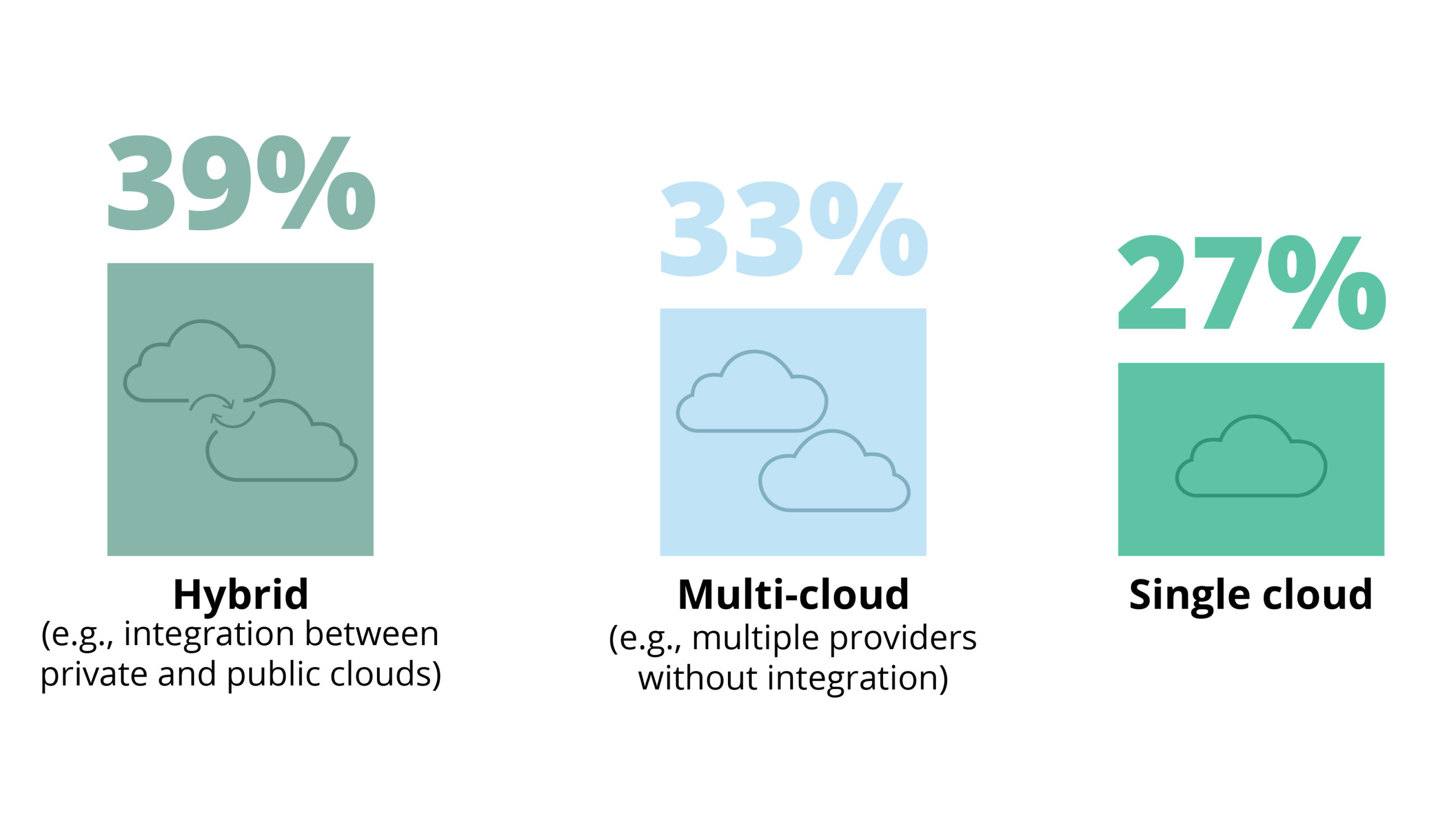The cloud, once an enigmatic concept, has become indispensable for businesses, providing efficiency gains and agility to adapt and respond to changes. Today, cloud computing capabilities support nearly every operation, process, and strategic decision.
Hybrid cloud vs multi-cloud
Companies are transitioning operations to cloud-based infrastructure and services to better scale, adapt, and optimize costs. Adopting the right cloud models and tools is essential for every business, from nimble startups to established industry giants. When it comes to choosing a cloud strategy for an enterprise, there are several key considerations as the evolution of cloud computing has brought about many options, each with its own set of advantages and challenges.
Beyond the well-known public cloud model (where computing resources are owned and provided by a third-party service provider), there exist several other cloud computing environments designed for specific organizational needs. These include:
Private cloud: Dedicated cloud infrastructure operated solely for a single organization, either on-premises or by a third-party provider.
Community cloud: A shared cloud platform for organizations with common interests or requirements, such as those within the same industry or government sector.
Distributed cloud: A cloud model where services are distributed across multiple physical locations but managed as a unified entity.
Edge cloud: Computing resources are brought closer to the data source, enabling faster processing and reduced latency.
Hybrid cloud: A combination of private and public cloud environments, allowing workloads to move between the two based on organizational requirements.
Multi-cloud: The use of multiple public cloud providers within a single heterogeneous architecture.
Virtual private cloud (VPC): An isolated, private environment within a public cloud, offering enhanced security and control.
The Flexera 2023 State of the Cloud Report claims that 87% of respondents reported having a multi-cloud strategy, and 72% are taking a hybrid approach by combining the use of both public and private clouds.
Cloud models adoption

The cloud computing paradigm has shifted significantly towards hybrid cloud and multi-cloud deployments as organizations strive for greater flexibility, redundancy, and smarter ways to manage their IT spending. Today, we dig deeper into reasons for enterprises to adopt hybrid or multi-cloud strategies over other models, providing distinct advantages that align with business goals and operational needs.
The cloud conundrum: hybrid cloud or multi-cloud?
Enterprises find themselves at a crossroads, grappling with whether to employ a hybrid cloud approach or venture into the multi-cloud universe.
The hybrid harmony: striking a balance
The hybrid cloud model blends public and private cloud resources, covering diverse needs of modern enterprises. Using the best of both worlds, organizations can draw on the scalability and cost-efficiency of public clouds while maintaining control over mission-critical workloads within their private cloud environments. This symbiosis allows for seamless data and application mobility between private and public clouds, enabling enterprises to optimize resource allocation and enhance operational resilience.
However, the hybrid cloud approach is not without its challenges. Maintaining consistent security policies, ensuring data integrity across disparate environments, and managing complex integrations can present formidable obstacles, particularly for organizations with limited cloud expertise. Nonetheless, proponents of the hybrid cloud approach highlight its ability to balance flexibility and control, making it an attractive option for enterprises looking for a gradual transition to the cloud.
Hybrid cloud adoption drivers
- Desire to gradually transition to the cloud without fully replacing existing on-premises infrastructure
- Need to maintain control and security over mission-critical workloads and data
- Compliance or regulatory requirements that mandate keeping certain data or systems on-premises, or within geographical boundaries
- Leveraging public cloud scalability and cost benefits while retaining private cloud advantages

Hybrid cloud adoption challenges
- Integrating and managing multiple cloud environments (public and private)
- Ensuring consistent security, governance, and compliance policies across environments
- Potential performance issues or latency due to data transfer between clouds
- Lack of advanced cloud skills and experience among IT teams
The multi-cloud enthusiasm: embracing versatility
With increasing technological complexity, more enterprises are moving their workloads to multi-cloud environments using several public cloud services from various providers like Amazon Web Services (AWS), Microsoft Azure, and Google Cloud Platform. Companies choose multi-cloud deployments for several reasons: to prevent over-reliance on a single vendor, take advantage of each provider’s specialized offerings, enhance system uptime by distributing workloads across clouds, and more. This supports healthy competition among vendors, driving innovation and preventing vendor lock-in, which is a pervasive concern in the cloud computing landscape.
98% of enterprises are using or plan to use at least two cloud infrastructure providers, and 31% are using four or more.
Moreover, the multi-cloud paradigm offers supreme resilience and redundancy, as mission-critical applications and data can be distributed across multiple providers, mitigating the risk of catastrophic failures or outages. This diversification strategy helps enterprises minimize downtime and ensure business continuity.
In a recent public endorsement of adopting a multi-cloud strategic approach, the U.S. Pentagon announced a $9B cloud contract with Amazon, Microsoft, Oracle, and Google, which is a clear statement of intent to select the most appropriate cloud service for the specific use case.
However, a multi-cloud approach is not without its fair share of complexities. Maintaining consistent cloud infrastructure governance, security, and compliance across multiple platforms can be a herculean task, often requiring specialized expertise and robust management tools. Additionally, the potential for increased costs and operational overhead looms large, as enterprises face differing billing models and service offerings.
Multi-cloud adoption drivers
- Avoiding vendor lock-in by distributing workloads across multiple providers
- Taking advantage of best-of-breed services from different cloud vendors
- Ensuring high availability and disaster recovery by spreading infrastructure across multiple clouds
- Meeting diverse application requirements that a single cloud can’t optimally satisfy
Multi-cloud adoption challenges
- Managing and governing infrastructure, data, and applications across multiple heterogeneous cloud platforms
- Ensuring consistent security, compliance, and cost optimization across providers
- Potential cloud vendor lock-in due to lack of effective multi-cloud management tools
- Complexity of migrating data and applications between cloud providers
- Lack of cloud experience and skills to effectively manage a multi-cloud environment
Multi-cloud vs hybrid cloud: unified for business growth, divided by features
| Element/Feature | Multi-cloud | Hybrid cloud |
|---|---|---|
| Architecture | Organizations that use multiple cloud solutions typically need to ensure compatibility between these cloud services and their existing on-premises solutions. | A hybrid cloud environment offers a complete package with centralized logging, identity management, alert systems, and cloud monitoring tools. |
| Security | It is challenging to maintain a centralized organization’s overall security posture, as security mechanisms, controls, and technologies can vary significantly across cloud environments. | A unified suite of tools and services securely integrates private cloud, public cloud, and on-premises resources into a unified environment, simplifying implementation. |
| Intercloud resource federation | Separate cloud services are used for diverse independent data operations. | Use of on-premises and cloud applications is coordinated to fulfill a function. |
| Controls | Businesses often leverage multiple clouds simultaneously, each with its own distinct control plane. | A single, centralized control plane manages workloads across various cloud environments. |
| Consistency | Diverse cloud services are available, as each cloud provider offers unique implementations of their tools and services. | Consistent Identity and Access Management (IAM) frameworks, monitoring tools, and other services are essential across all hybrid cloud workloads. |
While a hybrid cloud allows for a gradual transition, maintaining an integrated on-premises and public cloud environment, a multi-cloud setup offers more flexibility but increases complexity. The optimal approach depends on an enterprise’s existing infrastructure, cloud maturity, application portfolio, skills, and strategic goals. Many organizations adopt a multi-cloud migration strategy over time as they gain more cloud experience after an initial hybrid model.
However, the choice between hybrid cloud and multi-cloud is not mutually exclusive. Many enterprises adopt a hybrid multi-cloud strategy, combining on-premises infrastructure with multiple public cloud providers to achieve the benefits of both architectures.
Hybrid and multi-cloud: an orchestrated strategy for enterprise resilience
With the key distinctions of hybrid cloud and multi-cloud services, many businesses depart from the traditional one-size-fits-all mentality and employ elements of both hybrid and multi-cloud models to optimize their IT architecture and operations. The advantages of this approach are manifold: increased flexibility, enhanced disaster recovery capabilities, improved security posture, and the ability to leverage best-in-class services from multiple providers while minimizing cloud waste.
There are some viable reasons for adopting hybrid cloud and multi-cloud architectures:
Flexibility and scalability
One of the primary factors to consider is the level of flexibility and scalability required for your organization’s workloads. While hybrid cloud setups let you use both public and private cloud infrastructure and resources, multi-cloud environments take flexibility a step further by distributing workloads across different cloud providers. This approach better supports the dynamic needs of modern enterprises to scale resources up or down based on demand, ensuring cost optimization and efficient resource use.
Netflix employs a multi-cloud strategy to handle fluctuating demand and ensure seamless service delivery.
Greater vendor choice and cost savings

Avoiding dependence on a sole provider and optimizing the budget are vital aspects to consider for every business. Multi-cloud setups can mitigate the risk of vendor lock-in, as they allow organizations to leverage strengths as well as competitive pricing from different cloud providers and avoid being too reliant on a single vendor. This can lead to expense reduction and provide more negotiating power when partnering with cloud service providers.
General Electric (GE) has adopted a multi-cloud approach, leveraging various cloud providers, including AWS, Microsoft Azure, and Google Cloud Platform, to meet their diverse business needs.
Going hybrid or multi-cloud is not just about preventing vendor lock-in. Most organizations deploy a hybrid cloud (39%) or multi-cloud strategy (33%) to benefit from multiple services and support business continuity.
The primary cloud deployment strategy

Source: Fortinet
Performance and resilience
Performance and resilience are essential for the success and sustainability of modern enterprises. Multi-cloud architectures can optimize performance and improve disaster recovery by customizing cloud strategies for specific workloads and applications. This approach increases agility and reduces downtime caused by provider outages or service disruptions. This distributed approach to cloud infrastructure can enhance resilience and ensure that businesses can continue operating even in the face of unforeseen circumstances.
Cloud-based businesses can tackle disaster recovery in just 2.1 hours, compared to 8 hours for non-cloud businesses, according to Aberdeen Group
Control and security
Hybrid clouds keep sensitive data in private infrastructure while using a public cloud for less sensitive tasks. Multi-cloud setups offer security through redundancy and workload distribution. Leading cloud services like AWS, Azure, Google Cloud, Microsoft 365, and Salesforce provide robust security features. Coupled with effective hybrid and multi-cloud security measures (such as network segmentation, security software, and robust multifactor authentication policies), they offer comprehensive protection. In response to the increasing risk of ransomware attacks, a strong backup strategy with logical air-gaps, PoLP (the Principle of Least Privilege), immutability, and encryption while diversifying security protocols across multiple cloud providers bolsters data safety and business resilience.
Zesty reports that 59% of tech leaders opt for hybrid or multi-cloud solutions for security, as they prefer not to rely solely on one vendor’s security protocols, believing their data is safer with multiple cloud providers.
Data sovereignty and compliance
A multi-cloud architecture allows organizations to adhere to data sovereignty laws by selectively storing data across different cloud regions that align with specific regulatory requirements. This approach proves particularly advantageous for industries subject to stringent regulations concerning data residency within defined geographic boundaries. By leveraging multiple cloud providers, companies can customize their data storage practices, conforming with diverse regulatory standards and effectively mitigating risks associated with non-compliance.
Also, certain industries or regions may have specific regulatory requirements, which can be met by distributing workloads across multiple cloud environments. Hybrid cloud architectures allow organizations to keep sensitive data on-premises while leveraging public cloud resources for non-critical workloads, addressing data sovereignty and compliance requirements.
Financial institutions like JPMorgan Chase and Bank of America have implemented hybrid cloud strategies to comply with data sovereignty and regulatory requirements while benefiting from cloud scalability.
Cloud management and integration
As hybrid and multi-cloud environments become more complex, cloud management tools provide a centralized platform for monitoring, orchestrating, and optimizing cloud resources across disparate environments. Companies like VMware, Cisco, and HashiCorp are leading the charge in developing robust cloud management solutions that simplify operations, enhance visibility, and ensure compliance.

Furthermore, integration of edge computing is emerging as a critical component of enterprise IT strategies. With the proliferation of Internet of Things (IoT) solutions and the need for real-time data processing, edge computing brings computing resources closer to the data source, reducing latency and enhancing performance. Hybrid and multi-cloud architectures integrate edge computing capabilities, allowing enterprises to process and analyze data at the edge while still taking advantage of the cloud’s scalability and resources.
Sustainability as a business imperative
Accenture claims that businesses can reduce their carbon footprint by 84% when migrating to cloud services. Hybrid and multi-cloud setups enable resource sharing through cloud bursting and server consolidation, reducing idle resources and emissions. They allow for smooth application and data movement across public and private clouds while maintaining consistency. Additionally, a multi-cloud model reduces risks like supply chain issues and climate-related data center failures by offering flexibility and control over technology providers, promoting sustainability through better infrastructure decisions.
Salesforce has been using a hybrid multi-cloud approach that combines its own Salesforce Cloud with other public cloud providers like AWS and Google Cloud. This strategy helps Salesforce balance workloads and optimize resources for better energy efficiency and sustainability.
Scenario modeling using AI and cloud computing-powered digital twins can improve infrastructure efficiency by identifying performance bottlenecks, capacity constraints, and latency issues. Digital twins can recommend optimizations like load balancing or data tiering to enhance overall system performance.
Best practices for multi-cloud and hybrid implementation
The cloud is now the foundation for many technological advancements, including composable business models that showcase its resilience, scalability, flexibility, and speed during uncertain times. Hybrid, multi-cloud, and edge environments are expanding, paving the way for innovative distributed cloud models. According to McKinsey, $8 out of every $10 for IT spend goes to cloud services, and global cloud adoption will continue to expand. It’s vital to approach cloud implementation and modernization with well-weighed arguments, not hype.
Develop a cloud strategy. Define a clear strategy and roadmap for adopting hybrid and multi-cloud environments, considering factors such as cloud readiness, workload requirements, data sovereignty, and security needs.
Walmart has developed a comprehensive cloud strategy, leveraging multiple cloud providers including Microsoft Azure, Google Cloud, and AWS to support its digital transformation and e-commerce operations.
Implement robust cloud governance. Establish policies, processes, and tools for managing and monitoring hybrid and multi-cloud environments, ensuring compliance, security, and cost control.
Siemens has implemented a solid cloud governance framework to manage its hybrid and multi-cloud environments, ensuring consistency, security, and cost optimization across its operations.
Employ cloud-agnostic tools and services. Adopt platform-independent cloud solutions that integrate with multiple cloud providers, enabling portability and interoperability. Cloud-agnostic tools also reduce the budget and burden of training resources to become experts in each vendor’s tools.
Volkswagen Group has adopted cloud-agnostic tools like Kubernetes and Terraform to manage its hybrid and multi-cloud infrastructure, enabling seamless workload portability and consistent management across different cloud environments.
Enact interconnected security practices. Ensure that security measures, such as access controls, encryption, and continuous monitoring, are consistently applied across all cloud environments.
Pfizer has applied robust security measures, including multi-factor authentication, encryption, and continuous monitoring, to protect its sensitive data and applications across its hybrid and multi-cloud environments.
Manage cloud costs effectively. Administer cost optimization strategies, such as right-sizing resources, leveraging automated scaling, and monitoring cloud spend across all environments.
Airbnb has introduced cost optimization strategies, including automated scaling and right-sizing of resources, to effectively manage its cloud costs across multiple cloud providers.
Train and upskill staff. Provide training and development opportunities for IT staff to acquire the necessary skills for managing and maintaining hybrid and multi-cloud environments.
Accenture has invested heavily in training and upskilling its workforce to develop expertise in managing hybrid and multi-cloud environments, enabling them to better serve their clients’ cloud transformation needs
Find a partner for cloud connectivity. As your organization navigates the intricacies of multi-cloud and hybrid environments, a reliable cloud advisor is essential. Examine market options to find a partner who can provide solutions that fit your current needs and adapt to future opportunities. Experienced cloud experts will help you achieve your goals by understanding your requirements, conducting design workshops, customizing migration roadmaps, and providing ongoing implementation and support.
The verdict: embracing the future with open arms

As enterprises weigh cloud transformation, they must carefully consider their unique requirements, risk tolerance, and long-term strategic objectives rather than simply labelling their approach as hybrid or multi-cloud. Ultimately, the future of enterprise computing lies not in adhering to a single, rigid path but in embracing the coexistence of various cloud models.
But business success isn’t only about technology. On top of making the best out of cloud market offerings and industry guidance, it’s about orchestrating an operational model with security, financial management, and interoperability considerations. By adopting a holistic, agile approach and using the strengths of both hybrid and multi-cloud strategies, enterprises can future-proof their operations, foster innovation, and achieve a strategic market advantage.





